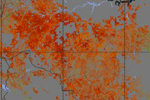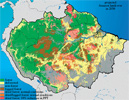Tropical forests may be less sensitive to global warming than previously thought, argues a new study published in Nature Geoscience.
The research is based on computer simulations using 22 climate models for tropical forests in Africa, Asia, and the Americas. It projects loss of forest biomass as a result of climate change only in the Americas.
However the study is far from conclusive, with the authors listing several uncertainties about how tropical forests will respond to climate change.
“The big surprise in our analysis is that uncertainties in ecological models of the rainforest are significantly larger than uncertainties from differences in climate projections,” said lead author Chris Huntingford of the Centre for Ecology & Hydrology in the UK. “Despite this we conclude that based on current knowledge of expected climate change and ecological response, there is evidence of forest resilience for the Americas (Amazonia and Central America), Africa and Asia.”
In other words, the modeling suggests that forests may be less sensitive to die-off from climate change alone. Earlier projections using one of the same climate models — the HadCM3 developed by the UK Met Office’s Hadley Centre — forecast massive die-off in the Amazon by 2011, potentially tipping much of the world’s largest rainforest toward a drier, savanna-like ecosystem.

Tropical forest biomass predictions for the Americas (a), Africa (b) and Asia (c) by 2011 using 22 climate models. Copyright Huntingford et al 2013. Click to enlarge.
However forests are not out of the woods yet. Importantly, the study ignored the impacts of deforestation, forest degradation from logging, and fire on the resilience of tropical forests. Other research — including observations in Borneo and the Amazon — indicates these can exacerbate the effects of drier and warmer conditions.
The authors therefore note the importance of incorporating these factors into projecting the future of tropical forests.
“This study highlights why we must improve our understanding of how tropical forests respond to increasing temperature and drought. Different vegetation models currently simulate remarkable variability in forest sensitivity to climate change,” said David Galbraith from the University of Leeds. “And while these new results suggest that tropical forests may be quite resilient to warming, it is important also to remember that other factors not included in this study, such as fire and deforestation, will also affect the carbon stored in tropical forests. Their impacts are also difficult to simulate. It is therefore critical that modeling studies are accompanied by further comprehensive forest observations.”

Rainforest in Borneo. Photo by Rhett A. Butler
The paper comes a month after the publication of a Nature study that indicated faster plant growth due to higher concentrations of carbon dioxide may offset increased emissions from forest die-off in the tropics. The study also did not account for the effects of deforestation and forest degradation, nor methane emissions.
Other recent research has suggested a less optimistic view for tropical forests. Another Nature study, published last November, warned that trees worldwide are more vulnerable to drought-stress than previously thought, while advanced laser and chemical imaging in the Amazon — detailed last December — produced evidence of large-scale tree die-off in a remote part of the Amazon due to climate-driven drought conditions. The long-term implications of those findings remains unclear — the dead forest areas could rebound.
CITATION: Chris Huntingford at al (2013). ‘Simulated resilience of tropical rainforests to CO2-induced climate change‘. Nature Geoscience doi:10.1038/ngeo1741
Related articles
(02/08/2013) Faster plant growth due to higher concentrations of carbon dioxide may offset increased emissions from forest die-off in the tropics, claims a new study based on climate modeling.
Amazon rainforest failing to recover after droughts
(12/24/2012) The impact of a major drought in the Amazon rainforest in 2005 persisted far longer than previously believed, raising questions about the world’s largest tropical forest to cope with the expected impacts of climate change, reports a new study published in the journal Proceedings of the National Academy of Sciences.
Advanced technology reveals massive tree die-off in remote, unexplored parts of the Amazon

(12/12/2012) Severe drought conditions in 2010 appear to have substantially increased tree mortality in the Western Amazon, a region thought largely immune from the worst effects of changes occurring in other parts of the world’s largest rainforest, reported research presented last week at the fall meeting of the American Geophysical Union (AGU). The findings suggest that the Amazon may face higher-the-expected vulnerability to climate change, potentially undercutting its ability to help mitigate greenhouse gas emissions by absorbing carbon dioxide through faster growth.
Forests worldwide near tipping-point from drought

(11/23/2012) Forests worldwide are at ‘equally high risk’ to die-off from drought conditions, warns a new study published this week in the journal Nature. The study, conducted by an international team of scientists, assessed the specific physiological effects of drought on 226 tree species at 81 sites in different biomes around the world. It found that 70 percent of the species sampled are particularly vulnerable to reduction in water availability. With drought conditions increasing around the globe due to climate change and deforestation, the research suggests large swathes of the world’s forests — and the services they afford — may be approaching a tipping point.
Deforestation, climate change threaten the ecological resilience of the Amazon rainforest
(01/19/2012) The combination of deforestation, forest degradation, and the effects of climate change are weakening the resilience of the Amazon rainforest ecosystem, potentially leading to loss of carbon storage and changes in rainfall patterns and river discharge, finds a comprehensive review published in the journal Nature.
2010 Amazon drought released more carbon than India’s annual emissions
(10/09/2011) The 2010 drought that affected much of the Amazon rainforest triggered the release of nearly 500 million tons of carbon (1.8 billion tons of carbon dioxide) into the atmosphere, or more than the total emissions from deforestation in the region over the period, estimates a new study published in the journal Environmental Research Letters.
Climate change and deforestation pose risk to Amazon rainforest

(05/20/2011) Deforestation and climate change will likely decimate much of the Amazon rainforest, says a new study by Brazil’s National Institute for Space Research (INPE) and the UK’s Met Office Hadley Centre. Climate change and widespread deforestation is expected to cause warmer and drier conditions overall, reducing the resistance of the rainforest ecosystem to natural and human-caused stressors while increasing the frequency of extreme rainfall events and droughts by the end of this century. While climate models show that higher temperatures resulting from global climate change will threaten the resilience of the Amazon, current deforestation is an immediate concern to the rainforest ecosystem and is likely driving regional changes in climate.
Last year’s drought hit Amazon hard: nearly a million square miles impacted

(03/29/2011) A new study on its way to being published shows that the Amazon rainforest suffered greatly from last year’s drought. Employing satellite data and supercomputing technology, researchers have found that the Amazon was likely hit harder by last year’s drought than a recent severe drought from 2005. The droughts have supported predictions by the Intergovernmental Panel on Climate Change’s (IPCC) that climate change, among other impacts, could push portions of the Amazon to grasslands, devastating the world’s greatest rainforest. “The greenness levels of Amazonian vegetation—a measure of its health—decreased dramatically over an area more than three and one-half times the size of Texas and did not recover to normal levels, even after the drought ended in late October 2010,” explains the study’s lead author Liang Xu of Boston University.
Two massive droughts evidence that climate change is ‘playing Russian roulette’ with Amazon
(02/03/2011) In 2005 the Amazon rainforest underwent a massive drought that was labeled a one-in-100 year event. The subsequent die-off of trees from the drought released 5 billion tons of CO2. Just five years later another major drought struck. The 2010 drought, which desiccated entire rivers, may have been even worse according to a new study in Science, adding on-the-ground evidence to fears that climate change may inevitably transform the world’s greatest rainforest.
Drought threatens the Amazon rainforest as a carbon sink

(03/05/2009) Drought in the Amazon is imperiling the rainforest ecosystem and global climate, reports new research published in Science. Analyzing the impact of the severe Amazon drought of 2005, a team of 68 researchers across 13 countries found evidence that rainfall-starved tropical forests lose massive amounts of carbon due to reduced plant growth and dying trees. The 2005 drought — triggered by warming in the tropical North Atlantic rather than el Niño — resulted in a net flux of 5 billion tons of carbon dioxide (CO2) into the atmosphere — more than the combined annual emissions of Japan and Europe — relative to normal years when the Amazon is a net sink for 2 billion tons of CO2.
Half the Amazon rainforest will be lost within 20 years

(02/27/2008) More than half the Amazon rainforest will be damaged or destroyed within 20 years if deforestation, forest fires, and climate trends continue apace, warns a study published in Philosophical Transactions of the Royal Society B. Reviewing recent trends in economic, ecological and climatic processes in Amazonia, Daniel Nepstad and colleagues forecast that 55 percent of Amazon forests will be “cleared, logged, damaged by drought, or burned” in the next 20 years. The damage will release 15-26 billion tons of carbon into the atmosphere, adding to a feedback cycle that will worsen both warming and forest degradation in the region. While the projections are bleak, the authors are hopeful that emerging trends could reduce the likelihood of a near-term die-back. These include the growing concern in commodity markets on the environmental performance of ranchers and farmers; greater investment in fire control mechanisms among owners of fire-sensitive investments; emergence of a carbon market for forest-based offsets; and the establishment of protected areas in regions where development is fast-expanding.
Greenhouse gas emissions have already caused the Amazon to dry
(02/27/2008) Anthropogenic emissions of greenhouse gases have already caused the Amazon to dry, finds a new study published in Philosophical Transactions of the Royal Society B.
Small fires a big threat to Amazon rainforest biodiversity
(02/27/2008) Small fires have a big impact in the Amazon rainforest, report researchers writing in Philosophical Transactions of the Royal Society B. The findings suggest a dire future for Earth’s largest rainforest.
Amazon rainfall linked to Atlantic Ocean temperature
(02/25/2008) Climate models increasingly forecast a dire future for the Amazon rainforest. These projections are partly based on recent research that has linked drought in the Amazon to sea surface temperatures in the tropical Atlantic. As the tropical Atlantic warms, the southern Amazon — the agricultural heartland of Brazil — may see higher temperatures and less rainfall.
Large-scale Amazon deforestation or drying would have dire global consequences
(02/21/2008) A new study shows that large-scale degradation of the Amazon, either through drying or continued deforestation, would have global consequence, including worsening climate change, causing regional vegetation shifts, and increasing dust in the atmosphere.
Global warming – not el Nino – drove severe Amazon drought in 2005
(02/20/2008) One of the worst droughts on record in the Amazon was caused by high temperatures in the Atlantic rather than el Nino. The research, published in Philosophical Transactions of the Royal Society B, suggests that human-driven warming is already affecting the climate of Earth’s largest rainforest.